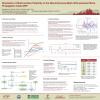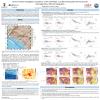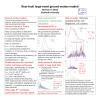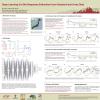Poster #209, Ground Motions
Detailed space-time variations of shallow velocity changes from dense array data
Poster Image:

Poster Presentation
2020 SCEC Annual Meeting, Poster #209, SCEC Contribution #10258 VIEW PDF
31 small events with magnitudes below 3.1 are used to compute the apparent velocity variations. In a second analysis, temporal evolution of properties is computed using moving time windows in continuous waveform over one-hour long data with noise and earthquake signals. The apparent velocity changes and recovery time are frequency dependent and present a strong spatial variability across the array. The resolved changes are larger and recovery time shorter with data associated with higher frequencies. Using 10-20 Hz, the apparent changes during the passage of the S- and P-waves from the small local events show average velocity changes over the whole network of 15% and 6%, respectively. The apparent velocity changes decrease to less than 1% for frequencies near 10 Hz. The relatively large changes in response to very low ground motion have important implications on nonlinear processes involving degradation and healing of the subsurface material during common earthquake shaking.
SHOW MORE
SHOW MORE




































































